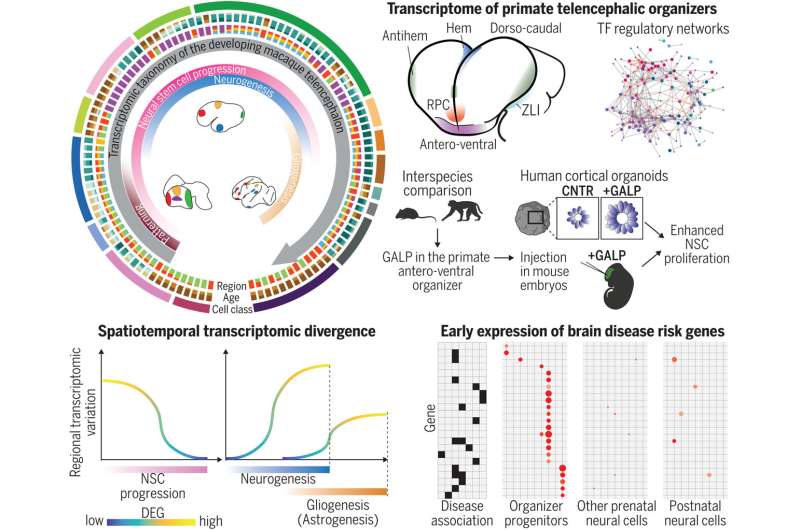This article has been reviewed according to Science X's editorial process and policies. Editors have highlighted the following attributes while ensuring the content's credibility:
fact-checked
peer-reviewed publication
trusted source
proofread
Researchers identify key genes in the development of the primate brain

The development of the brain requires an elaborate, tightly organized chain of events that are jumpstarted by neural stem cells, which give rise to increasingly specialized cells that carry out all brain functions. But what molecular events occur during this process that account for differences in the brains of primates and mice?
In a new study, Yale researchers have used brain organoids (small, three-dimensional replicas of the developing brain) to track changes created by neural stem cells in the brains of macaque monkeys and humans. After comparing the findings with insights drawn from previous studies of the brains of mice, they revealed the molecular origins of the developmental differences that distinguish primates from mice.
Among the key differences they observed was increased activation of GALP (Galanin-like peptide), a peptide previously implicated in energy metabolism and appetite, in the macaque and human brains.
The findings are published in the journal Science.
"It is important to understand how primate brains develop and where higher cognitive functions come from,"' said co-first author Nicola Micali, an associate research scientist in the lab of Pasko Rakic, the Dorys McConnell Duberg Professor of Neuroscience and professor of neurology at Yale School of Medicine.
Examination of brain organoids created from the human and monkey pluripotent stem cells showed the presence of GALP helped spur proliferation of neural stem cells in the primate brains, the researchers said. No such GALP-generated activity was found in the mouse brain.
"The finding suggests that GALP may play a role in the increased size and complexity of the primate brain across evolution," Micali said.
In addition, the researchers detected genes within neural stem cells that have been linked to neuropsychiatric disorders—such as schizophrenia and bipolar disorder—very early in the development of the fetal brain.
"This suggests the origins of these diseases occur much earlier in development than we had thought," Micali said.
The paper was one of 21 published as a series by the BRAIN Initiative Cell Network, which is compiling a comprehensive library of cell types in the brain.
Shaojie Ma, a postdoctoral associate in the lab of Nenad Sestan, the Harvey and Kate Cushing Professor of Neuroscience and professor of comparative medicine, of genetics, and of psychiatry at Yale School of Medicine, is co-first author of the paper.
More information: Nicola Micali et al, Molecular programs of regional specification and neural stem cell fate progression in macaque telencephalon, Science (2023). DOI: 10.1126/science.adf3786




















